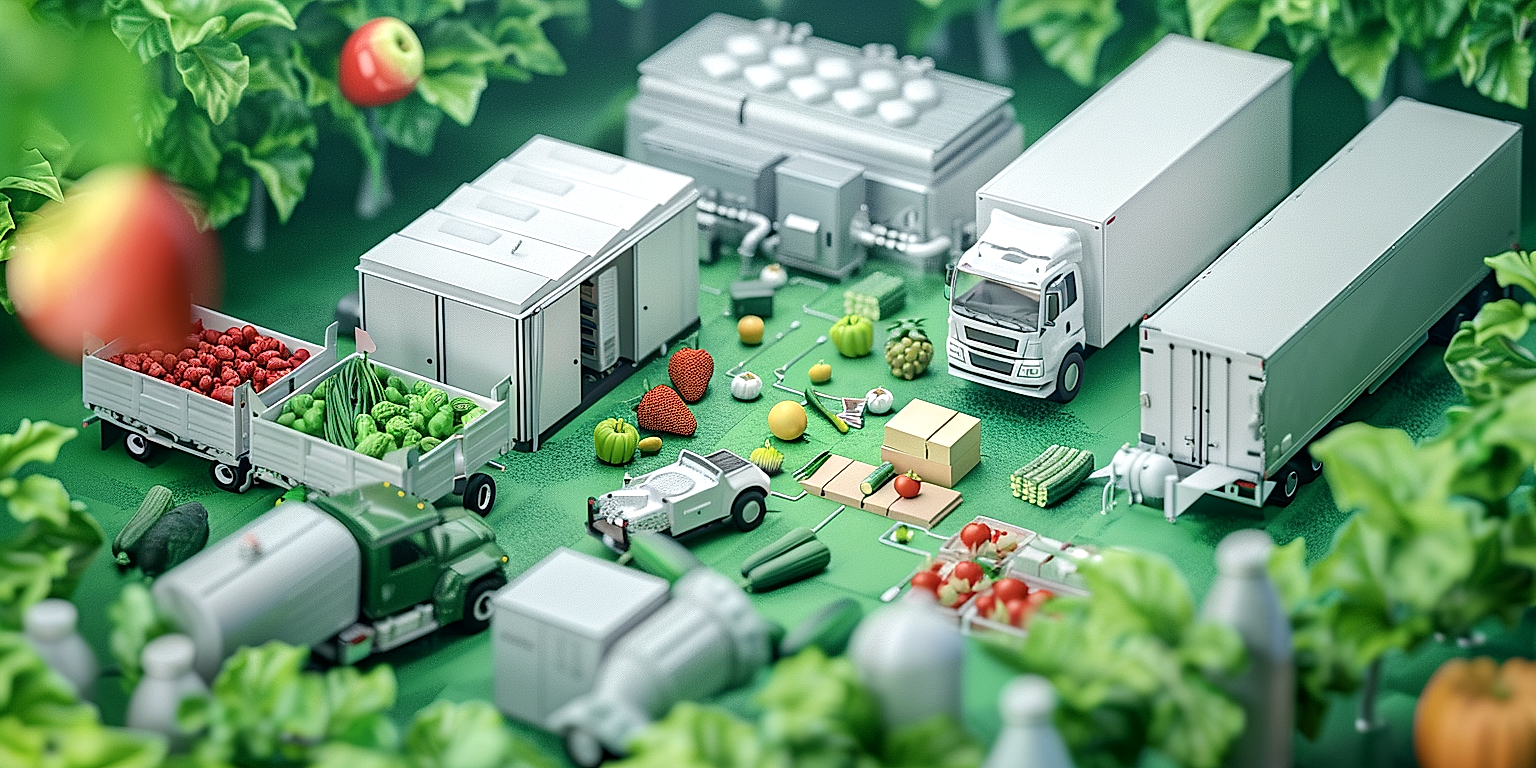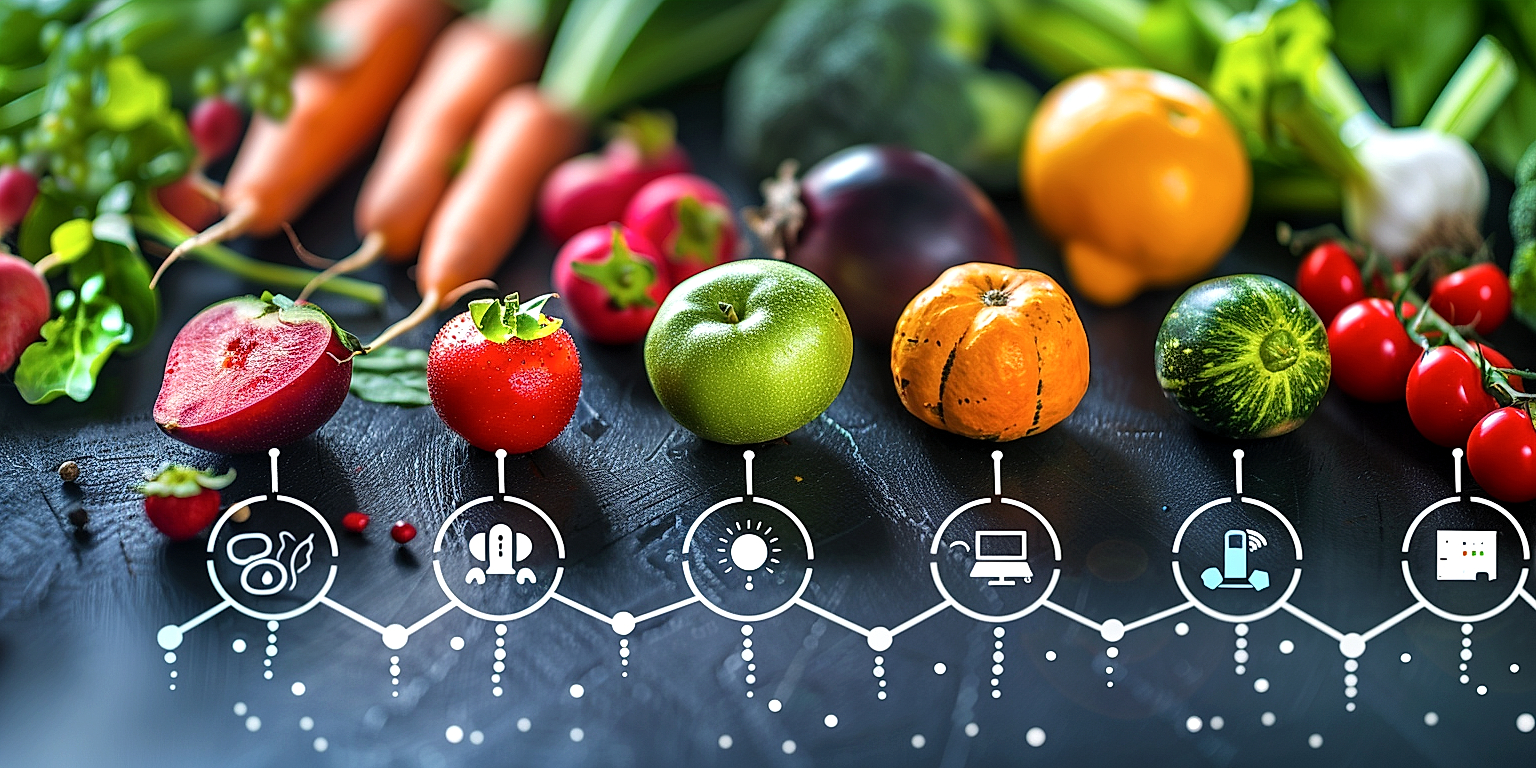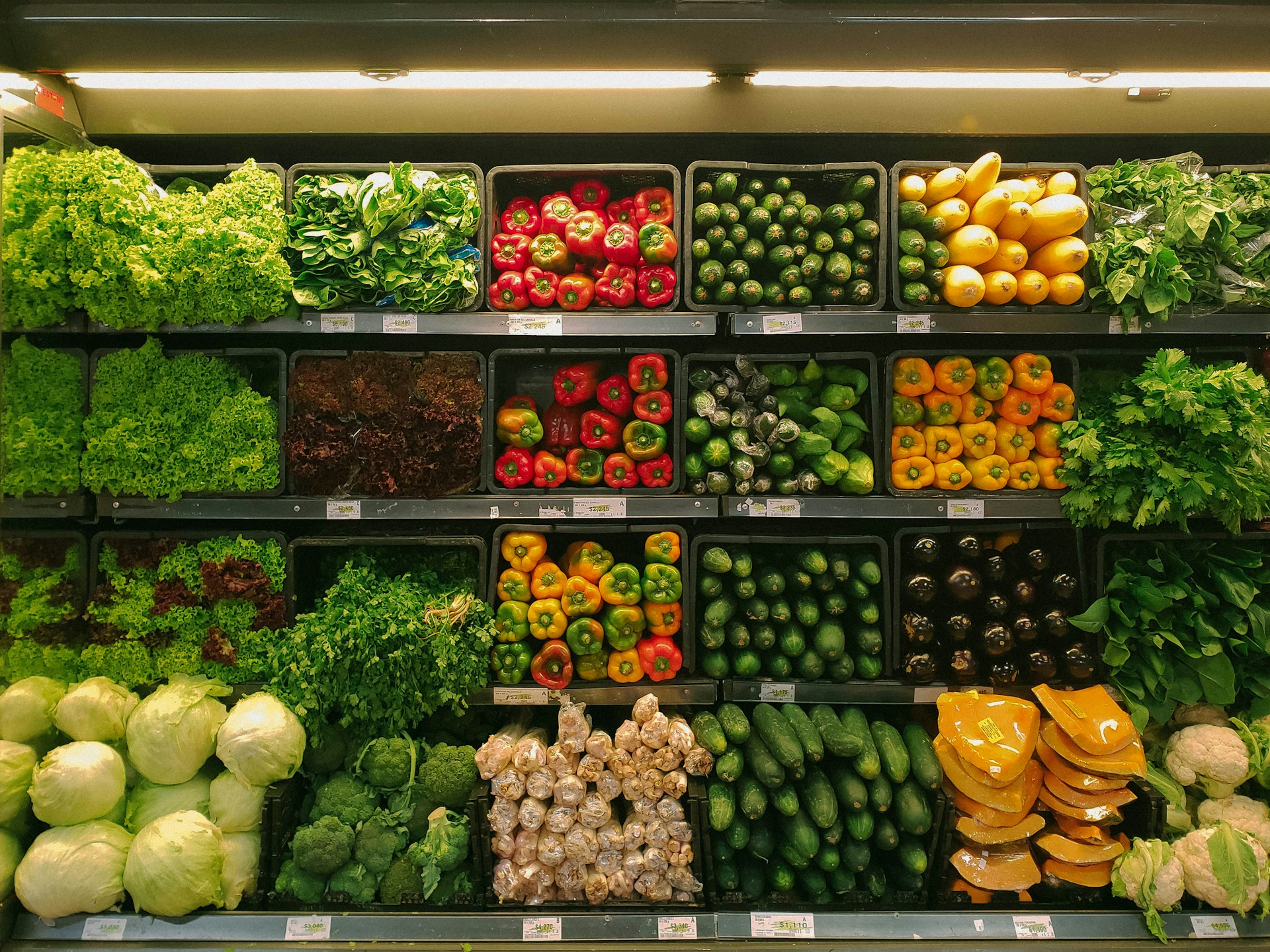Managing the delicate nature of perishable goods, particularly produce, presents unique challenges that require precise, efficient strategies.
Cold chain logistics, an integral part of this process, is essential in maintaining the freshness, quality, and safety of these products during distribution.
This relies heavily on various factors, each playing a pivotal role in ensuring the success of this intricate operation.
From temperature control to storage optimisation, the right implementation can lock in produce freshness from farm to fork.
While the stakes are high, accurately navigating these elements can lead to reduced waste, maximised profits, and customer satisfaction.
In order to deepen the understanding of what truly makes for successful produce distribution, we will dwell into the key success factors for cold chain logistics.
Contents
- Key Success Factors For Cold Chain Logistics In Produce Distribution
- 1. Efficient refrigeration and cooling systems
- 2. Accurate Temperature Monitoring and Control
- 3. Reliable transportation and network infrastructure
- 4. Skilled Workforce for Logistics Management
- 5. Quick Response to Unforeseen Disruptions
- 6. Compliance with Food Safety Regulations
- 7. Effective supply chain visibility
- 8. Proper Packaging to Maintain Product Freshness
- 9. Adequate Warehouse Storage and Capacity
- 10. Sustainable practices to reduce environmental impact.
- The Bottom Line
Key Success Factors For Cold Chain Logistics In Produce Distribution
1. Efficient refrigeration and cooling systems
The success of cold chain logistics in produce distribution greatly relies on efficient refrigeration and cooling systems.
These systems are critical to maintaining the freshness and quality of the produce during transportation and storage.
Without effective refrigeration, produce can easily spoil, leading to significant losses for both distributors and retailers.
Today’s refrigeration systems are designed to offer continuous and precise temperature control, ensuring that produce remains at the optimal temperature throughout the entire supply chain journey.
This is particularly crucial for items that are highly perishable, such as fruits, vegetables, and dairy products.
Modern refrigeration and cooling systems are also designed to be energy-efficient, which is not only beneficial for the environment but also helps to reduce operational costs.
The choice of a refrigeration system largely depends on the type of produce being transported and the specific temperature requirements.
For instance, bananas require a different temperature compared to berries or leafy greens.
Hence, it’s critical for logistics managers to have a thorough understanding of the specific refrigeration needs for each product they handle.
Frost-free technology is another innovation in modern refrigeration systems that helps prevent the build-up of ice within the cooling unit.
This not only improves the efficiency of the system but also extends its lifespan and contributes to maintaining the quality of the produce.
Furthermore, efficient refrigeration and cooling systems must be coupled with regular maintenance to ensure their reliability and longevity.
Breakdowns in the cooling system can result in temperature fluctuations which could negatively impact the produce and even lead to food safety issues.
Therefore, having regular checks and maintenance schedules is critical to the success of cold chain logistics.
Moreover, smart refrigeration systems which can provide real-time data about temperature changes and malfunctions are now available, giving logistics managers better control and visibility into their cold chain operations.
Last but not least, training for personnel handling these systems is essential.
They must understand the importance of effective refrigeration and be able to respond swiftly and adequately to any issues that might arise.
2. Accurate Temperature Monitoring and Control
In cold chain logistics, the importance of precise temperature monitoring and control can not be overstated.
This particular aspect is fundamental to ensuring the preservation of quality and nutritional value in distributed produce.
Variations in temperature can lead to the proliferation of bacteria and fungi in food products, which in turn can cause spoilage or the spread of diseases.
As such, implementing robust and accurate temperature monitoring and control mechanisms is a key success factor in cold chain logistics for produce distribution.
Produce distributors that strive to maintain accurate temperature monitoring and control are more likely to achieve product quality, consumer satisfaction, and regulatory compliance.
Furthermore, it’s worth noting that such mechanisms are not just about maintaining low temperatures.
They are about maintaining the right temperatures, since different types of produce might require different temperature levels.
Inaccurate temperature settings could lead to frost damage in certain fruits, while other types of produce might not stay fresh if the temperatures are not low enough.
Hence, accuracy in temperature control plays a critical role in preserving the freshness and safety of a wide range of produce including fruits, vegetables, dairy products, meats, seafood, and more.
Notably, the efficiency of these mechanisms does not merely depend on the technology used in refrigeration and cooling systems.
It also involves the ability to promptly detect and respond to temperature fluctuations and breaches.
This entails the use of advanced technologies such as real-time monitoring tools, data loggers, and IoT devices, which can provide instantaneous information and alerts about temperature changes.
Moreover, the effectiveness of temperature control can also hinge on factors like proper packaging, adequate insulation, and optimized routing for transportation.
In summary, the implementation of accurate temperature monitoring and control mechanisms is a multi-faceted process that requires a strategic approach, technological adeptness, and a commitment to quality.
By prioritizing this aspect, produce distributors can significantly enhance their cold chain logistics, meet the high expectations of consumers, and stay compliant with food safety regulations.
3. Reliable transportation and network infrastructure
Reliable transportation and network infrastructure is a critical success factor for cold chain logistics in produce distribution.
For maintaining the quality of produce from farm to the table, it is necessary to have a transportation system that ensures consistently low temperatures.
Produce must be transported in vehicles equipped with effective refrigeration systems capable of controlling temperature and humidity levels.
The integrity of the cold chain depends heavily on the reliability of these transportation systems.
Any breakdown or failure in transportation may expose the produce to unsuitable conditions, thus risking its freshness and even causing financial loss.
To avoid such mishaps, transport vehicles must undergo regular maintenance and quality checks to ensure their optimal performance.
Similarly, the network infrastructure is crucial for coordinating and monitoring the different stages of the cold chain distribution process.
A well-established network infrastructure enables efficient tracking and management of the transportation fleet, cargo schedules, and the condition of the transported produce.
Digital technologies such as GPS tracking, IoT sensors, and data analytics are instrumental in enhancing the efficiency and reliability of this infrastructure.
They allow for remote monitoring of transportation conditions, real-time route optimization, and quick response to any disruptions.
Moreover, leveraging digital technology also contributes to the transparency and accountability of the cold chain logistics process.
It is essential to ensure that the network infrastructure is backed up by a fitting IT support system.
Up-to-date, closely integrated software and hardware systems are crucial in maintaining the smooth flow of information and connectivity across the cold chain network.
Seamless communication and data sharing among all involved parties serve to refine decision-making and risk management strategies.
Finally, a reliable network infrastructure must incorporate measures for cybersecurity to protect against data breaches and other potential threats, which could severely hamper the operation of cold chain logistics.
In essence, reliable transportation and solid network infrastructure are instrumental in successfully managing the intricacies of cold chain logistics in produce distribution.
4. Skilled Workforce for Logistics Management
Having a skilled workforce for logistics management is crucial in ensuring the success of cold chain logistics within the produce distribution sector.
This is because a competent team of logistics professionals can plan, coordinate, and monitor every stage of the cold chain process, from sourcing, packaging and storage, to transportation and delivery.
Their expertise ensures that delicate products like perishable produce are handled appropriately, and stored and transported under the right conditions.
Training employees on the aspects of cold chain logistics not only improves their understanding but also enables them to work more effectively, thus reducing the risks of spoilage and wastage.
Additionally, trained personnel are more likely to comply with food safety regulations, ensuring that the quality and safety of the perishable goods are maintained from production to consumption.
Quality training and equipping the logistics team with the necessary skills for managing a cold chain infrastructure can significantly improve the efficiency of the supply chain, and ultimately, the profitability of the business.
Moreover, well-trained employees know how to respond swiftly and effectively to unforeseen disruptions such as machinery breakdown can minimize losses and maintain the integrity of the produce.
On top of knowledge and technical skills, having soft skills such as problem-solving, critical thinking and effective communication are critical for the swift resolution of issues that may arise during the logistics process.
Also, they’re crucial for efficient logistics management as they enable personnel to interrelate productively and make sound decisions, which, in turn, optimizes the overall operations of the cold chain.
Leveraging on technology is also important to the success of cold chain logistics in the produce distribution sector.
Logistics professionals should be well-versed in the latest digital and automated tools available in the market, right from warehouse management systems to data analytics tools.
Incorporating these tools into the cold chain management can enhance monitoring, improve accuracy and promote transparency throughout the supply chain.
Moreover, they help to identify and rectify potential issues before they escalate into significant problems that can disrupt the cold chain logistics and impair service delivery.
It’s hence significant to prioritize ongoing training and development programs for employees to keep them abreast with the changing trends in the cold chain logistics landscape.
Such knowledge can be invaluable in improving the efficiency, reliability and overall success of the cold chain logistics process.
Ultimately, the success of cold chain logistics in produce distribution largely depends on having a skilled and competent logistics workforce that is equipped with the appropriate knowledge, skills, and technological know-how.
5. Quick Response to Unforeseen Disruptions
In the realm of cold chain logistics in produce distribution, the ability to quickly respond to unforeseen disruptions is historically significant and crucial.
In an industry where products can swiftly deteriorate if not adequately controlled, unexpected obstacles can lead to vast financial losses and impact customer satisfaction.
One setback can lead to a domino effect across the entire supply chain if not addressed immediately.
The management of these unpredicted disruptions requires integrated and efficient contingency plans.
The contingency planning involves proactive risk analysis and management in order to anticipate disruptions and prepare for action.
This also includes fostering a reactive adaptability to allow for immediate corrective action when an unexpected event occurs.
Prioritizing business continuity is essential, and to accomplish this, businesses need comprehensive business continuity plans that are up-to-date and relevant.
Train staff to react immediately and effectively to unforeseen challenges, to minimize any potential damage.
It is important to remember that unforeseen disruptions can be internal or external.
Internal disruptions may include equipment failure or unexpected staff shortage, while external disruptions can involve sudden weather changes, logistics delays or even global pandemics.
A strong network of diversified suppliers and multiple transportation options can be beneficial to provide flexibility in response to disruptions.
Besides, strong relationships with all supply chain partners can enhance communication and collaboration during a crisis.
A quick response time not only minimizes losses but can also turn a potentially damaging situation into a competitive advantage.
It is through the successful management of these unforeseen disruptions that a cold chain distribution network truly proves its efficiency and reliability.
Overall, the ability to quickly respond to unforeseen disruptions is key in maintaining the integrity of the cold chain logistics process in produce distribution.
It is not enough to merely contain the potential damage as it happens, but also to learn from it and implement improvements to prevent its recurrence.
6. Compliance with Food Safety Regulations
Compliance with food safety regulations is essential in the sector of cold chain logistics in fresh produce distribution.
In order to maintain the quality of fresh products and prevent any possible health hazards, strict adherence to food safety regulations is needed at every stage of the process, from harvesting through storage to distribution.
This requires an in-depth understanding of various national and international food safety standards and regulations related to the handling and transportation of fresh products.
The regulations often prescribe specific temperature ranges for storing and transporting different types of fresh produce, as well as guidelines for their handling to prevent contamination and ensure hygiene.
Failure to comply with these regulations can result in significant financial penalties, loss of business, and damage to the company’s reputation.
Moreover, the health and safety of the consumers are paramount, and any lapse in adhering to food safety regulations can pose serious risks to public health.
Therefore, the importance of maintaining compliance with food safety regulations cannot be overemphasized in cold chain logistics for fresh produce distribution.
To achieve this, companies must invest in equipment and technologies that can keep fresh produce in prescribed temperature ranges and avoid any risks of contamination.
They should also train their workforce in the understanding and application of food safety regulations as well as in the use of cooling and storage equipment that ensures the freshness and safety of products.
The companies must regularly audit their processes and systems to ensure ongoing compliance with the safety regulations.
Additionally, investing in advanced technologies can help in maintaining the quality and safety of fresh produce, from the point of origin to the point of consumption.
These technologies can provide real-time monitoring of temperature, humidity, and other critical factors to ensure compliance and traceability.
Moreover, cold chain logistics for fresh produce distribution must also consider the potential impacts of global warming and climate change on food safety regulations.
There may be changes in established norms or the introduction of new regulations to adapt to changing climate patterns and the mounting pressure to reduce the environmental impact of logistics operations.
Last but not least, ensuring compliance with food safety regulations is not just about avoiding penalties or loss of business, but also about building customer trust and improving brand reputation.
Companies that demonstrate their commitment to food safety by strictly adhering to regulations can enhance their credibility and competitive advantage in the market.
Overall, compliance with food safety regulations forms an essential pillar of success in cold chain logistics in fresh produce distribution.
7. Effective supply chain visibility
The effective visibility of the supply chain is crucial for the successful operation of cold chain logistics in the distribution of produce.
This involves a clear understanding of every step in the supply chain, from the sourcing of raw materials to the delivery of finished goods to the final consumer.
Thorough monitoring is essential to identify any potential bottlenecks or delays that could harm the quality of the produce or disrupt the schedule.
Digital technologies such as IoT devices and cloud-based software platforms can enhance the visibility of the supply chain.
This allows for real-time updates on the status and condition of goods throughout the transportation and storage processes.
In the context of cold chain logistics, effective visibility can help in maintaining temperature control, ensuring product freshness, and complying with food safety regulations.
Supply chain visibility allows for proactive decision-making, where logistics managers can address issues before they impact the efficiency of the distribution process.
It also supports accurate forecasting, enabling businesses to predict demand and schedule production accordingly.
Beyond internal operations, supply chain visibility can improve customer satisfaction.
Customers today demand transparency and ethical sourcing, and having a visible supply chain can help to meet these expectations, building trust and loyalty in the long run.
A visible supply chain can also contribute to corporate social responsibility by helping to reduce environmental impact.
For example, by identifying areas where energy consumption can be minimized or waste can be reduced, companies can make their operations more sustainable.
Having a fully visible supply chain thus has wide-ranging benefits, from increasing operational efficiency to enhancing customer relations and promoting sustainability.
The rise of digital technology is set to further accelerate the shift towards greater supply chain visibility.
Through tools like blockchain technology, businesses can achieve a wholly transparent and traceable supply chain, bringing the concept of end-to-end visibility closer to reality.
This clear visibility of supply chains plays a crucial role and can be considered a critical success factor in cold chain logistics for produce distribution.
8. Proper Packaging to Maintain Product Freshness
Successful cold chain logistics highly lean on the proper packaging that significantly contributes to maintaining product freshness and quality.
In produce distribution, the packaging plays a vital role as it provides an additional layer of protection to the product, preserving its nutritional values and preventing any potential damage.
Developing effective packaging begins with understanding the unique requirements of the produce being distributed.
This means considering factors like product sensitivity, perishability, as well as any regulatory requirements that dictate the acceptable practices in produce packaging.
Thus, the effectiveness of a packaging solution is determined by its ability to minimize the impact of external factors such as heat, humidity, light, and mechanical shocks, which can considerably reduce the freshness of the product.
By keeping these factors in check, packaging aids in maintaining the desired temperature and the product’s condition during the transit process.
An emerging trend in the cold chain logistics industry is the use of innovative packaging technologies like modified atmosphere packaging and vacuum packaging.
These technologies are designed to prolong the shelf-life of perishable foods, thereby ensuring products reach consumers fresh and safe, reducing waste and increasing profitability for suppliers.
Proper packaging is not just about protecting the produce; it’s also about meeting customer expectations.
Consumers today are more aware and demand evidence of good handling practices, which include the condition of the packaging when they receive their orders.
Thus, the role of packaging in maintaining product freshness should not be underestimated in cold chain logistics.
It’s vital to remember that all packaging should meet regulatory requirements and safety standards to avoid any legal fines or repercussions that could harm the company’s reputation.
Moreover, it’s crucial to continuously explore and adopt innovative packaging techniques and materials that are not only efficient in maintaining product freshness, but also sustainable and environmentally friendly.
Despite the challenges, continuous efforts to develop better packaging solutions that meet these requirements can significantly enhance the effectiveness of cold chain logistics in produce distribution, resulting in satisfied customers and efficient operations.
Indeed, proper packaging is not just a protocol but a critical success factor influencing the overall effectiveness of a cold chain logistics system.
It can serve as a powerful tool for businesses to differentiate themselves in a competitive market, driving customer satisfaction and loyalty, and ultimately leading to sustainable growth and profitability.
9. Adequate Warehouse Storage and Capacity
In the realm of cold chain logistics for produce distribution, the component of adequate warehouse storage and capacity cannot be rendered insignificant.
Lack of sufficient space for storing and handling products can lead to major operational difficulties and potential loss of quality or waste of produce.
For any cold-chain logistic process to function smoothly, it is vital to maintain the required amount of temperature-controlled space for specific produce.
As cold chain storage is specialized in nature, having adequate warehouse storage, that caters particularly to the needs of different types of produce is imperative.
The warehouse must be equipped with necessary components like refrigerators, freezers, HVAC systems, and insulation to maintain the optimal temperature for different produce.
Moreover, it should also have systems to monitor and regulate temperature and humidity levels proactively.
The configuration of the storage area should ideally allow easy access and efficient movement of goods, minimizing any potential damage or exposure to adverse conditions.
Each storage area within the facility must be clearly labeled with the types of produce stored, defined by their specific temperature and storage needs.
A well-organized and spacious warehouse capacity allows more room for growth and can accommodate any seasonal variations in produce demand and supply.
Besides, handling and storage procedures need to be strictly followed to ensure that the produce retains its freshness and quality throughout the logistics chain.
To achieve this, regular audits and inspections of the storage methods and condition of the produce can be of great help.
Warehouse teams must also be regularly trained to handle and store produce efficiently, reducing waste and ensuring the highest quality reaches consumers.
Furthermore, the facility’s stocking policy must be in line with the FIFO (First In First Out) principle to mitigate the risk of spoilage.
Therefore, understanding the specific storage requirements and developing an adequate warehousing system, is an undeniable key to successful cold chain logistics.
Focusing on adequate warehouse storage and capacity not only helps maintain the quality of the produce but also increases operational efficiency, thereby reducing costs and potential wastes.
10. Sustainable practices to reduce environmental impact.
Sustainability is an increasingly important consideration in all sectors of business, including cold chain logistics in produce distribution.
Green practices help to conserve resources, save energy, and ultimately, safeguard our planet for future generations.
Businesses in the cold chain logistics sector can make significant strides towards sustainability in numerous ways.
One such way is by optimizing routing and load management to minimize fuel consumption and slash carbon emissions.
Upgrading to more efficient refrigeration units can also curtail energy use and reduce the carbon footprint of the operation.
Implementing a strict waste management policy can help to minimize waste, another vital step towards sustainability.
Moreover, businesses can leverage renewable energy sources, such as solar power, to power warehouses and refrigeration units.
Another promising approach to sustainability is the use of clean vehicles, such as electric or hydrogen fuel cell powered trucks, which can drastically decrease greenhouse gas emissions.
Embracing sustainable practices not only helps to reduce the environmental impact but can also engender trust and loyalty among consumers who are increasingly conscious about the environment, thereby enhancing brand image and potentially improving the bottom line.
Just as important is the need to ensure that suppliers in the supply chain are also adhering to sustainable practices.
By doing so, the entire chain works together to reduce its overall environmental footprint, while maintaining optimum efficiency.
This collaborative approach also fosters partnerships and strengthens the resilience of the supply chain.
Finally, it’s worth noting that sustainability is not a one-off initiative, but requires a long-term commitment to continuous improvement.
Continually monitoring, reviewing, and enhancing sustainable practices are essential to staying ahead of the curve and keeping pace with evolving industry standards and consumer expectations.
Overall, sustainable practices are a truly critical success factor for cold chain logistics in produce distribution, enabling companies to thrive in an environmentally conscious marketplace while also caring for our planet.
The journey towards sustainability can be challenging, but with perseverance and dedication, it can yield significant rewards for businesses, consumers, and the environment alike.
The Bottom Line
Having explored the critical elements of successful cold chain management for the perishables industry, it becomes evident how crucial each component is.
From efficient refrigeration and cooling, accurate temperature control to reliable transportation and network infrastructure, they form a harmonized system.
The competence of logistics management personnel can affect this system just as much as unexpected disruptions.
Adherence to food safety regulations, optimal supply chain visibility, and proper maintenance of product freshness through packaging are just as vital elements.
Supplementing these key components with adequate warehouse storage, capacity, and advocating for sustainable practices underscore how the effectiveness of the cold chain can be both achieved and maintained.
Thus, each strand of this systematic tapestry works diligently towards minimizing waste, maintaining the quality of perishable goods and, ultimately, ensuring consumer satisfaction.




